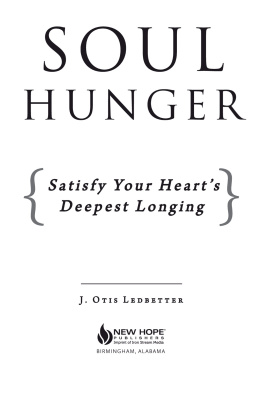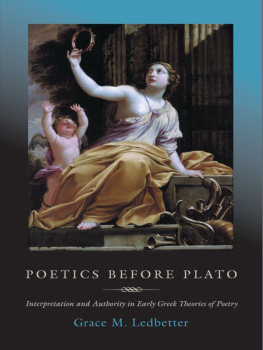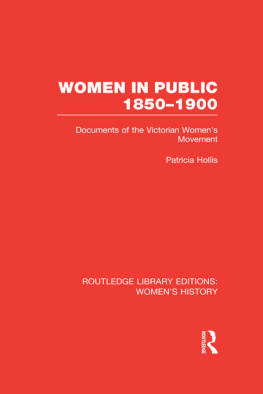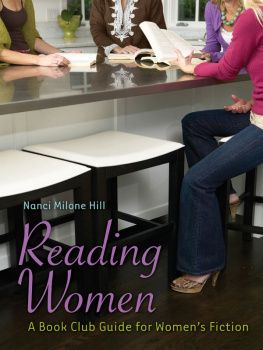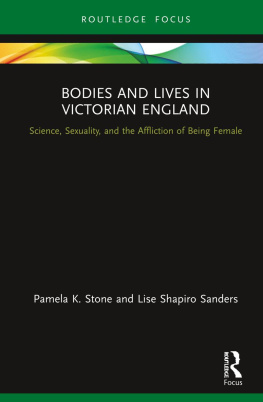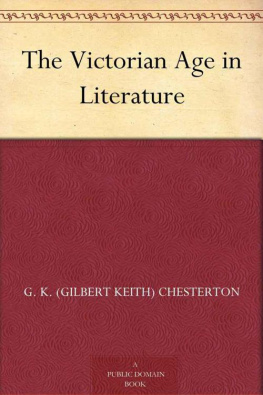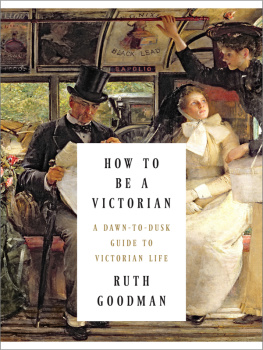VICTORIAN NEEDLEWORK
Kathryn Ledbetter

Copyright 2012 by Kathryn Ledbetter
All rights reserved. No part of this publication may be reproduced, stored in a retrieval system, or transmitted, in any form or by any means, electronic, mechanical, photocopying, recording, or otherwise, except for the inclusion of brief quotations in a review, without prior permission in writing from the publisher.
Library of Congress Cataloging-in-Publication Data
Ledbetter, Kathryn.
Victorian needlework / Kathryn Ledbetter.
p. cm. (Victorian life and times)
Includes index.
ISBN 978-0-313-38660-2 (hardback) ISBN 978-0-313-38661-9 (ebook)
1. WomenGreat BritainSocial conditions19th century. 2. Needlework, Victorian. I. Title.
HQ1593.L43 2012
746.4320941dc23 2011040017
ISBN: 978-0-313-38660-2
EISBN: 978-0-313-38661-9
16 15 14 13 12 1 2 3 4 5
This book is also available on the World Wide Web as an eBook.
Visit www.abc-clio.com for details.
Praeger
An Imprint of ABC-CLIO, LLC
ABC-CLIO, LLC
130 Cremona Drive, P.O. Box 1911
Santa Barbara, California 93116-1911
This book is printed on acid-free paper 
Manufactured in the United States of America
Recent Titles in Victorian Life and Times
Family Ties in Victorian England
Claudia Nelson
Food and Cooking in Victorian England
Andrea Broomfield
Victorian Religion: Faith and Life in Britain
Julie Melnyk
Gone to the Shops: Shopping in Victorian England
Kelley Graham
Victorian Childhoods
Ginger S. Frost
Victorian Technology: Invention, Innovation, and the Rise of the Machine
Herbert Sussman
Health, Medicine, and Society in Victorian England
Mary Wilson Carpenter
The Sporting Life: Victorian Sports and Games
Nancy Fix Anderson
Courtship and Marriage in Victorian England
Jennifer Phegley
Here practise and invention may be free.
And as a squirrel skips from tree to tree,
So maids may (from their mistress or their mother)
Learn to leave one worke, and to learne another,
And skip from worke to worke, from stitch to stitch,
Until, in time, delightful practise shall
(With profit) make them perfect in them all.
Thus hoping that these workes may have this guide
To serve for ornament, and not for pride:
To cherish vertue, banish idlenesse,
For these ends, may this booke have good successe.
John Taylor, from The Needles Excellency (1631)
CONTENTS
ACKNOWLEDGMENTS
I would like to thank Victorian Life and Times series editor Sally Mitchell for supporting me in this project and for much graceful correction to my manuscript. I also thank Praeger Press for producing such an entertaining, scholarly series. Steve Catalano and Mariah Gumpert and the staff of copyeditors at Praeger Press deserve much gratitude for helping to prepare this manuscript for press.
I thank Mike Hennessy and Ann Marie Ellis from Texas State University for a travel grant that allowed me to attend the exhibit and symposium at the Victoria and Albert Museum Quilts: 17002010. I would also like to thank curators and attendants at the Needle Museum in Redditch; Quarry Bank Mill Museum in Manchester; Gawthorpe Hall; the Paisley Museum in Paisley, Scotland; the British Quilt Museum in York; and the Museum of Rochester for allowing me to view samples of Victorian needlework and textiles in their collections. Many thanks to Beth Palmer at the University of Leeds and Catherine Waters at the University of Kent for inviting me to speak at their respective institutions during my tour. I am also very grateful to William Scheuerle for inviting me to speak on this topic at the University of South Florida and to the Wimberley Valley Quilt Guild and the New Braunfels Area Quilt Guild for inviting me to present programs on British Victorian needlework.
Members of many organizations supported me in various, very important ways. These organizations include the Research Society for Victorian Periodicals, British Quilt Study Group, American Quilters Society, International Quilt Association, British Association of Victorian Studies, and the Interdisciplinary Nineteenth-Century Studies Association. I am especially grateful to members of the American Quilt Study Group, who generously and regularly share insights about quilt history. Many thanks to my colleagues William Volckening, Alice McElwain, and Kathleen McHugh for their inspiration and support during quilt-appraisal and fabric-dating classes at the American Quilters Society 2011 show in Paducah, Kentucky.
I warmly thank my quilting cheerleaders Susan Cranshaw, Mary Tomlinson, Maggie Alvis, Marian Birnie, Rouye Rush, Rosemary Duke, Wilma Hurt, and Sandy Rich. Phyllis Jordan deserves special gratitude for encouraging me to pursue my dreams and for helping me clarify this manuscript. Many thanks to my Texas State colleague Sue Beebe for listening to my adventures when she had other things to do and for proudly displaying my mini quilt in her office. I am also grateful to Katherine Adams, Dorcas Cresswell, Patricia Zakreski, and Jen Jones.
Thanks to my teachers Bobbie Aug, Gerald Roy, Carol Butzke, Linda Honsberger, Su and Dwayne Bunch, Joan Howes, Marcella Rich, Dea Heller, DeAnne Hartwell Jones, Sally Collins, and Brenda Papadakis. I also wish to thank Christine Bayles Kortsch, Talia Schaeffer, and Andrea Broomfield for much encouragement and advice. Scholars from the Victoria online discussion list provided suggestions about literary references to needlework. They include Rory Moore, Susan Hoyle, Sunie Fletcher, Mary Rimmer, Anne Croucher, Sheldon Goldfarb, Joellen Masters, Deborah Denenholz Morse, Ellen Jordan, SueAnn Schatz, Lynn Carpenter, Heather Dean, Sarah McNeely, Rohan Maitzen, Deborah Logan, Adrian Dover, and Jenny Sparks. Many thanks to Patrick Leary for providing this valuable resource for Victorian studies.
I am deeply grateful to have had women in my life who enjoyed needlework and shared what they could with me, an impatient and restless learner. These women include Joy Hicks Ledbetter, Opal Ledbetter, Viola Hicks, Paula Cudworth, and Elsie Hicks Cudworth. Thanks to Linda Johnson and Janice Ryals-Rogers, my patient and supportive travel companions. A special thanks to Sarah McNeely and Nora Kathryn McNeely-Bagley for a gift beyond words. Not least, I thank my insightful listener and banjo-playing hero, Alan Munde.
1
Significance: An Object of Ambition to Every British Fair
There are many women who persuade themselves that the occupations particularly allotted to their sex are extremely frivolous; but it is one of the common errors of a depraved taste to confound simplicity with frivolity. The use of the needle is simple, but not frivolous.
Ladies Needlework Penny Magazine
THE PRACTICE OF NEEDLEWORK IN THE VICTORIAN ERA
Needlework was important to a womans identity during the nineteenth century. Mothers taught their daughters how to sew at a very early age, often as soon as they could hold a needle. Activity for women almost always engaged some form of needlework. One writer proclaimed in December 1849 that never were fingers more actively engaged than those of the rising female generation; braiding, embroidery, Berlin work, knitting, netting, and crochet have been successively exhausted.young man was very important because equal opportunities for education and employment did not exist during the Victorian period. Society rarely expected intellectual capability in women beyond that required in their accepted roles as wife, mother, caretaker, and dependent. Men often viewed pretty hands busy with fancy work as naturally beautiful, and a young woman might practice stitching to show off while entertaining in her parlor.


